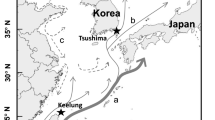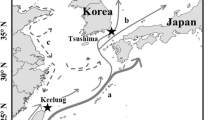Abstract
Squid typically display considerable intra-specific plasticity in size and age-at-maturity in response to ambient environmental conditions, yet little is known of the mechanisms driving these variations. We examined the intra-specific variability in Nototodarus gouldi reproductive traits to determine patterns of energy allocation between somatic and reproductive processes over short temporal scales. Females caught during the cool months of May and July were larger, had slower lifetime growth, lower gonad investment, and better somatic condition than females caught during the warmer months, suggesting a trade-off between gonad investment and somatic condition in females. On the other hand, males showed a tight coupling between somatic condition and gonad investment for most months, with increases in somatic and gonad tissue occurring concurrently. In male squid, an increase in lifetime growth rate was coupled with an increase in the relative weights of somatic and reproductive structures, whereas in females, percent increase in body weight per day was correlated only with gonad development. Patterns of repro-somatic investment in mature females had implications for spawning strategies, since female squid with higher levels of gonad investment apparently released batches of eggs together as a group, regardless of body size, whereas females with low gonad investment possibly spawned their eggs independently of one another. In terms of life-history theory, male squid were able to respond rapidly to environmental fluctuations without compromising either the gonad or the soma. However, although mature females did not appear to respond as quickly to ambient conditions, female squid possibly produced two different reproductive strategies, possibly to maximise offspring survival in either a stable or a variable environment. It seems from our study that monthly variations in ambient conditions may have large effects on life-history strategies.




Similar content being viewed by others
References
Arkhipkin A, Jereb P, Ragonese S (2000) Growth and maturation in two successive seasonal groups of the short-finned squid, Illex coindetii from the Strait of Sicily (central Mediterranean). ICES J Mar Sci 57:31–41
Boyle PR (1990) Cephalopod biology in the fisheries context. Fish Res 8:303–321
Boyle PR, Boletzky S (1996) Cephalopod populations: definition and dynamics. Philos Trans R Soc Lond B 351:985–1002
Boyle PR, Pierce GJ, Hastie LC (1995) Flexible reproductive strategies in the squid Loligo forbesi. Mar Biol 121:501–508
Butler A, Althaus F, Furlani D, Ridgway K (2002) Assessment of the conservation values of the Bonney upwelling area. Report to Environment Australia, December 2002. CSIRO Marine Research, Hobart, Tasmania
Calow P (1979) The cost of reproduction—a physiological approach. Biol Rev 54:23–40
Calow P (1987) Fact and theory—an overview. In: Boyle PR (ed) Cephalopod life cycles, vol 2. Comparative reviews. Academic Press, London, pp 351–366
Chai FS (1974) Classification and adaptive significance of development patterns in marine invertebrates. Thalassia Jugosl 10:121–130
Collins M, Burnell G, Rodhouse P (1995) Reproductive strategies of male and female Loligo forbesi (Cephalopoda: Loliginidae). J Mar Biol Assoc UK 75:621–634
Forsythe JW, Van Heukelem WF (1987) Growth. In: Boyle PR (ed) Cephalopod life cycles, vol 2, Comparative reviews. Academic Press, London, pp 135–156
González AF, Guerra A (1996) Reproductive biology of the short-finned squid Illex coindetii (Cephalopoda, Ommastrephidae) of the northeastern Atlantic. Sarsia 81:107–118
Green AJ (2001) Mass/length residuals: measures of body condition or generators of spurious results? Ecology 82:1473–1483
Harman RF, Young RE, Reid SB, Mangold KM, Suzuki T, Hixon RF (1989) Evidence for multiple spawning in the tropical oceanic squid Stenoteuthis oualaniensis (Teuthoidea: Ommastrephidae). Mar Biol 101:513–519
Hopper K (1999) Risk-spreading and bet-hedging in insect population biology. Annu Rev Entomol 44:535–560
Hughes RN, Roberts DJ (1980) Reproductive effort of winkles (Littorina spp.) with contrasted methods of reproduction. Oecologia 47:130–136
Jackson GD (1993) Seasonal variation in reproductive investment in the tropical loliginid squid Loligo chinensis and the small tropical sepioid Idiosepius pygmaeus. Fish Bull 91:260–270
Jackson GD, Domeier (2003) The effects of an extraordinary El Niño/La Niña event on the size and growth of the squid Loligo opalescens off southern California. Mar Biol 142:925–935
Jackson GD, Moltschaniwskyj N (2002) Spatial and temporal variation in growth rates and maturity in the Indo-Pacific squid Sepioteuthis lessioniana (Cephalopoda: Loliginidae). Mar Biol 140:747–754
Jackson GD, Forsythe JW, Hixon RF, Hanlon RT (1997) Age, growth, and maturation of Lolliguncula brevis (Cephalopoda: Loliginidae) in the northwestern Gulf of Mexico with a comparison of length-frequency versus statolith age analysis. Can J Fish Aquat Sci 54:2907–2919
Juanicó M (1983) Squid maturity scales for population analysis. FAO Tech Rep 231:341–378
Lewis AR, Choat JH (1993) Spawning mode and reproductive output of the tropical cephalopod Idiosepius pygmaeus. Can J Fish Aquat Sci 50:20–28
Mangold K (1987) Reproduction. In: Boyle (ed) Cephalopod life cycles, vol 2. Comparative reviews. Academic Press, London, pp 157–200
Maxwell M, Hanlon R (2000) Female reproductive output in the squid Loligo pealei: multiple clutches and implications for a spawning strategy. Mar Ecol Prog Ser 199:135–143
McGrath BL, Jackson DG (2002) Egg production in the arrow squid Nototodarus gouldi (Cephalopoda: Ommastrephidae), fast and furious or slow and steady? Mar Biol 141:699–706
Moltschaniwskyj NA (1995) Multiple spawning in the tropical squid Photololigo sp.: what is the cost in somatic growth? Mar Biol 124:127–135
Moltschaniwskyj NA, Semmens J (2000) Limited use of stored energy reserves for reproduction by the tropical loliginid squid Photololigo sp. J Zool (Lond) 251:307–313
O’Dor RK, Durward RD, Balch N (1977) Maintenance and maturation of squid (Illex illecebrosus) in a 15-meter circular pond. Biol Bull 153:322–335
O’Dor RK, Foy EA, Helm PL, Balch N (1986) The locomotion and energetics of hatchling squid, Illex illecebrosus. Am Malac Bull 4:55–60
Pecl G (2001) Flexible reproductive strategies in tropical and temperate Sepioteutis squids. Mar Biol 138:93–101
Philippi T, Seger J (1989) Fitness, uncertainty and the role of diversification in evolution and behavior. Am Nat 115:623–638
Rocha F, Guerra A, Gonzalez A (2001) A review of reproductive strategies in cephalopods. Biol Rev 76:291–304
Rochet M-J (2000) A comparative approach to life-history strategies and tactics among four orders of teleost fish. ICES J Mar Sci 57:228–239
Rodhouse PG, Hatfield EMC (1990) Dynamics of growth and maturation in the cephalopod Illex argentinus de Castellanos, 1960 (Teuthoidea: Ommastrephidae). Philos Trans R Soc Lond B 329:229–241
Roff DA (1992) The evolution of life histories: theory and analysis. Chapman and Hall, New York
Rowe VL, Mangold K (1975) The effect of starvation on sexual maturation in Illex illecebrosus (Lesueur) (Cephalopoda: Teuthoidea). J Exp Mar Biol Ecol 17: 157–163
Semmens J, Moltschaniwskyj N (2000) An examination of variable growth in the loliginid squid Sepioteuthis lessoniana: a whole animal and reductionist approach. Mar Ecol Prog Ser 193:193–141
Stearns SC (1992) The evolution of life histories. Oxford University Press, New York
Steer MA (2004) Embryonic development and early life history of the southern calamary, Sepioteuthis australis Quoy & Gammaird, 1832. Ph.D. Thesis, University of Tasmania
Steer MA, Moltchaniwskyj NA, Jordan AR (2003a) Embryonic development in southern calamary (Sepioteuthis australis) within the constraints of an aggregated egg mass. Mar Freshw Res 54:217–226
Steer MA, Pecl GT, Moltschaniwskyj NA (2003b) Are bigger calamary Sepioteuthis australis hatchlings more likely to survive? A study based on statolith dimensions. Mar Ecol Prog Ser 261:175–182
Tafur R, Villegas P, Rabi M, Yamashiro C (2001) Dynamics of maturation, seasonality of reproduction and spawning grounds of the jumbo squid Dosidicus gigas (Cephalapoda: Ommastrephidae) in Peruvian waters. Fish Res 54:33–50
Triantafillos L, Jackson GD, Adams M, McGrath Steer BM (2004) An allozyme investigation of species boundaries and stock structure in Australian populations of the arrow squid Nototodarus gouldi (Cephalopoda: Ommastrephidae). ICES J Mar Sci (in press)
Yampolsky LY, Scheiner SM (1996) Why larger offspring at lower temperatures? A demographic approach. Am Nat 147:86–100
Acknowledgements
We would like to thank G. Cottier for helping obtain squid samples from Portland, and T. McArthur and E. Green for providing assistance during squid dissections. We would also like to acknowledge G. Pecl for helpful comments made on an earlier version of the manuscript. The authors are grateful to Roger Hanlon and an anonymous reviewer who made thoughtful recommendations that greatly improved the manuscript. This research was supported by a Fisheries Research and Development Corporation Grant awarded to GDJ (ID 1999/112).
Author information
Authors and Affiliations
Corresponding author
Additional information
Communicated by M.S. Johnson, Crawley
Rights and permissions
About this article
Cite this article
McGrath Steer, B.L., Jackson, G.D. Temporal shifts in the allocation of energy in the arrow squid, Nototodarus gouldi: sex-specific responses. Marine Biology 144, 1141–1149 (2004). https://doi.org/10.1007/s00227-003-1289-z
Received:
Accepted:
Published:
Issue Date:
DOI: https://doi.org/10.1007/s00227-003-1289-z




